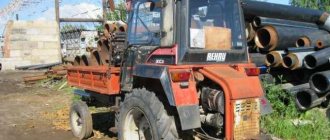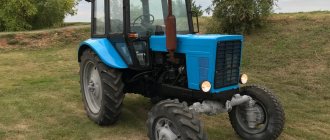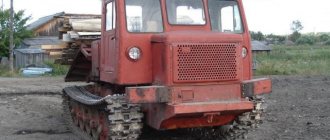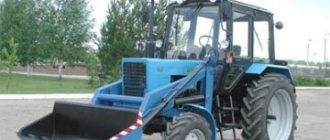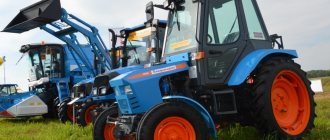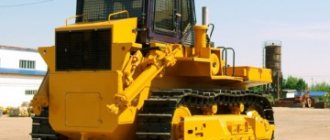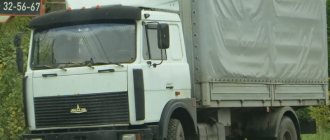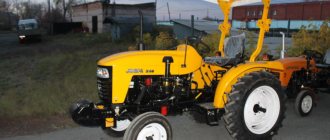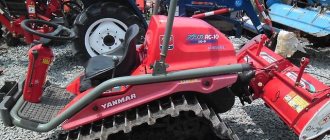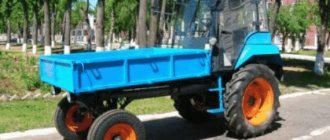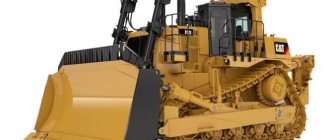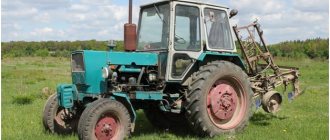The MTZ 80 universal row-crop tractor is one of the most popular among all models produced at the Minsk Tractor Plant. Such a unit can be successfully used not only in agriculture, but also in loading and unloading operations, and in the road construction sector. Thanks to increased cross-country ability, increased agrotechnical performance and improved traction and traction qualities, this equipment is quite universal in its application.
MTZ-80 tractor engine
The design of the MTZ-80 tractor is thought out literally down to the smallest detail. The basis of its design is the motor located in the front part of the unit. The high engine power allows the tractor to be assigned to traction class 1.4. The engine of the unit consists of 4 cylinders, the same number of contacts and a semi-separate combustion chamber. Engine operation under high loads is controlled by an efficient liquid cooling system. Some more modern models of MTZ tractors were also additionally equipped with a reliable pre-start heater, the presence of which made it possible to start the engine smoothly in severe frosts.
The first MTZ-80 models had relatively low power, but later more powerful engines with a volume of 4.75 liters began to be included in the units. Depending on the modification of the tractor, a battery-powered starter or a separate starting motor is responsible for starting the engine.
Design of the MTZ-80 and MTZ-82 tractor
- 1. BASIC INFORMATION
The MTZ-80 and MTZ-82 tractors are made according to the usual, so-called classical design (with rear wheels larger than the front ones) and have a semi-frame structure.
The tractors are equipped with a diesel engine (diesel engine) D-240 with start from an electric starter or D-240L with start from a carburetor starting engine (tractors with D-240L engines are respectively marked MT3-80JI and MT3-82J1).
A diesel engine with direct fuel injection and volumetric film mixture formation in a combustion chamber located in the piston develops a power of 59 kW (80 hp) at a rotation speed of 2200 rpm and a specific fuel consumption of 238 g/kW - h (185 g/ e.l.s h).
The main and starting engines are put into operation directly from the cab; when the gearbox is engaged, the diesel engine is started to be blocked. To facilitate starting at low temperatures, the diesel suction manifold is equipped with an electric torch heater.
The transmission provides an expanded and rational range of speeds: eighteen forward gears and four reverse gears. This makes it possible to effectively load the engine for various types of work, using increased operating speeds (9...15 km/h), as well as in the range of transport gears (18...35 km/h). A creeper, which, if necessary, is installed on the gearbox, allows you to obtain reduced technological speeds for special work (0.27...0.6 km/h).
The clutch is equipped with damper rubber elements - dampers of torsional vibrations of the diesel crankshaft. A brake is installed on the clutch shaft, which stops the shaft at the end of the clutch disengagement and thereby facilitates easier shifting and shock-free engagement of the gearbox gears.
The rear axle differential is locked automatically and forcibly by a hydraulically driven friction clutch connected to the power steering.
The rear power take-off shaft has independent (two-speed) and synchronous drives. The side power take-off shaft also has two gears.
In order to ensure stability and controllability of the tractor, as well as increase the efficiency of the front drive axle when mounting machines that unload the front wheels, a set of easily removable ballast weights is installed on the front beam bracket. Ballasting of the rear wheels is also provided.
To increase traction and traction and maneuverability in difficult soil conditions, the installation of a rubber-metal half-track, as well as attachments for pairing the rear drive wheels, is provided.
The separate-unit hydraulic system provides high-altitude and additional power and positional methods for regulating the position of mounted soil-cultivating machines relative to the tractor. Force and position control is automatic, based on sensors built into the tractor linkage mechanism that respond to changes in traction resistance and implement position. The versatility of control methods improves the quality of tillage (uniform plowing depth), improves productivity and makes it possible to use machines without support wheels. With mounted tillage machines that have support wheels, you can use a hydraulic system, which will allow you to redistribute the forces acting on the mounted machine and its working parts to the rear drive wheels of the tractor in order to increase traction.
To hold mounted machines in the upper position during transport crossings, the tractor's hitch is equipped with a mechanical lock for the swing arm of the hitch system. The locking mechanism is controlled from the cab.
The tractor's hitch is equipped with an automatic hitch, with the help of which you can, without leaving the cab, attach an aggregated machine with a similar hitch to the tractor.
To increase efficiency in transport work, the tractors are equipped with a towing device with a universal pneumatic system that provides brake actuators for heavy-duty transport trailers and other machines. To work with single-axle trailers, the tractor has a hydraulic tow hook. The tractor's pneumatic system can be used to inflate tires and for other purposes.
The tractor cabin is mounted on rubber shock absorbers and is not rigidly connected to the tractor frame, which reduces vibration and noise levels. The doors and walls of the cabin are upholstered with heat and noise insulating materials. The cabin is heated by a heater, which takes heat from the engine water system. In dusty and hot conditions, pre-cleaned, cooled and humidified air is supplied to the cabin. Natural ventilation of the cabin is provided through the opening roof and rear window.
To clean the front windshield, in addition to the wiper, an electric windshield washer is provided.
The single seat of the tractor driver is equipped with a torsion bar suspension and a hydraulic shock absorber. The position and rigidity of the seat are adjusted depending on the weight and height of the tractor driver. The position of the steering wheel can also be changed for ease of control and entry into the cabin.
The rigidity of the cab frame meets the safety requirements in case of emergency rollover of the tractor.
There are also seat belts that are attached to the seat. The shape of the cabin lining and the tractor as a whole is rationally linked to ease of maintenance and working conditions. File: Obshhayaya-kharakteristika-i-ustroystvo-MTZ.docx
Gearbox of the MTZ 80 tractor
To switch the speed mode, the Belarus MTZ-80 models are equipped with a 9-speed 2-band gearbox equipped with a high-quality reduction gearbox. The presence of such a gearbox allows the tractor to move at any of 18 forward and 4 reverse speeds.
If necessary, the unit can be equipped with a creeper. The rear axle is controlled, depending on the tractor modification, by a mechanical or hydraulic drive. Tractor models that came off the assembly line in recent years of production are equipped with a hydraulic gearbox.
Chassis of the MTZ-80 tractor
The MTZ-80 unit can be wheeled or tracked. The MTZ-80 wheeled tractor is equipped with rear drive wheels, which receive the force generated by the motor through a transmission. In the design of the MTZ-82 modification, the leading axle is the front axle, which is driven by the transmission and transfer case.
MTZ-80 tractors, which are equipped with tracks, have better stability when moving on loose soil, and can easily overcome obstacles in the form of ravines, wetlands or slippery ice.
Main modifications
Modifications of the MTZ-80 may differ in appearance (previous tractors have been tuned) and functional features:
- the type of rubber used;
- method of starting the engine.
Thus, the MTZ-80R model is equipped with an additional final drive (rear axle), and the MTZ-80N is produced with a lower center of gravity due to the installation of wheels with a smaller diameter. But the MTZ-82 tractor differs from the previous model only in all-wheel drive and the small size of the cabin.
Various types of engines can be installed - diesel D-240 (standard) or launched from a starting carburetor engine D-240L (MT3-80JI).
In the video you can see the MTZ-80 tractor, its cabin and main components:
Brake system of an agricultural machine
The main braking mechanism in the design of the MTZ-80 unit is a disc brake system. Dry brakes are provided in the shaft gears on the right and left sides of the front and rear axles.
Additionally, to stop the tractor, it is equipped with a parking brake. It is designed to hold equipment in areas located at an angle. Also, for long stops on slopes and inclines, the tractor design includes an auxiliary brake mechanism.
Cabin and unit interior
The Belarus MTZ-80 tractor is equipped with a spacious cabin. It is attached to the power frame using rubber shock absorbers, which effectively suppress noise from the operating transmission and tractor engine. The comfortable driver's seat can be adjusted in height.
The internal surfaces of the cabin of the MTZ-80 unit are finished with thermal and noise-absorbing material. There are rubber mats on the floor that prevent the driver's feet from slipping off the pedals. The interior of the tractor cabin will be clearly demonstrated in the photo.
Tractor MTZ-80 - technical characteristics and areas of application
A well-thought-out design and good balance of the Belarus MTZ-80 unit allowed the unit to acquire excellent technical characteristics. These include:
- power – 80 l. With.;
- cylinder working volume – 4.75 l;
- number of speeds – 18 forward/4 reverse;
- minimum ground clearance - 47 cm;
- fuel consumption under average loads – 230 gkW/h;
- weight – 3.77 t.
The dimensions of the MTZ-80 tractor are quite modest. The length of the unit is 3.93, width – 1.07 and height – 2.74 m.
The high power of the agricultural unit allows it to be used to perform the following tasks:
- for working with a plow for effective plowing of virgin soil and heavy clay soils;
- for harrowing and preparing rows before planting;
- for planting tuber crops and sowing seeds;
- for hilling beds, watering, distributing fertilizers and harvesting crops;
- for cleaning the garden after harvesting - mowing grass, making hay, cultivating the soil before the winter season;
- for transporting crops;
- for clearing the local area from snow and ice, as well as sweeping the roadway.
Very often in factories and warehouses, a kun is used in tandem with this popular unit, which allows the tractor to be used as a universal loader.
Specifications:
- power: 80 l. With.
- Engine: 4-stroke, 4-cylinder, diesel
- fuel consumption: 238 g/kW per hour
- speed: 34.31 km/h
- Gearbox: 18 forward and 4 reverse
- fuel tank: 130 l
- dimensions (length/width/height): 3815x1970x2470x mm
- structural weight: 3520 kg
- weight with all equipment: 6300 kg
- ground clearance: 470 mm
The MTZ 80 tractor is equipped with a sealed safe cabin with a stove, a ventilation system and a comfortable seat that is adjustable to the operator’s height. The electrical equipment of the unit consists of sources and consumers of electricity. The entire electrical system is made according to a single-drive scheme. Namely, all metal parts play the role of one of the current wires. By the way, here is the electrical diagram of this machine:
It is worth noting that this model of the unit has many modifications. Among the main ones, it is worth highlighting MTZ-80R, MTZ-80N and MTZ-82. The first model is equipped with an additional rear axle. The second is distinguished by its lower center of gravity, due to the fact that it is equipped with wheels of a smaller diameter. But the MTZ-82 is available with a small cabin and all-wheel drive.
Preparing the MTZ-80 tractor for work - a note for beginners
Each model of MTZ-80 tractors leaves the factory fully equipped for further work. Each unit comes with a full set of spare parts, tractor driver’s tools, detailed operating instructions and additional accessories. However, before starting the tractor, the farmer still has to perform a number of procedures aimed at facilitating the start of the engine and other mechanisms of the agricultural machine. Their list includes:
- Before starting, you need to thoroughly wash the tractor;
- After this, you will need to remove the standard batteries and bring them into working condition;
- Next, you need to remove the protective polyvinyl chloride covers;
- Then you will need to install the drain valves of the standard radiator cylinder block on the tractor;
- In accordance with the lubrication table, you need to lubricate the rubbing components and mechanisms of the tractor;
- Next, you need to fill the fuel tank with settled fuel;
- After this, you need to fill the engine cooling system with clean water;
- Next, you need to check the pressure in the tractor tires, as well as in the hydraulic system pipes;
- At the end, you will need to install charged batteries and widen the tractor track to 140 cm. The video will clearly demonstrate the preparation of the Belarus MTZ-80 tractor for work.
Completing all of the above procedures before each cold start of the engine will extend the life of the MTZ-80 tractor and eliminate its breakdown. Thanks to this, repairs to the unit will need to be performed much less frequently.
Repair and maintenance manual MTZ-80
Contents of the MTZ-80 repair and maintenance manual
/ MTZ 82 and MTZ 100 / MTZ 102. The book describes in detail and consistently the principles of operation, design and interaction of mechanisms, units and systems of tractors Belarus MTZ 80 / MTZ 82 and MTZ 100 / MTZ 102, sets out the basic rules for their competent operation and rational aggregation with machines and implements, recommendations on maintenance, adjustments, troubleshooting and troubleshooting, as well as safety precautions are presented.
1. Introduction 3 2. Technical data 4 3. Design and operation of the tractor 16 4. Design and operation of the tractor components 26 4.1. Diesel 27 4.1.1. Block and cylinder head 27 4.1.2. Crank mechanism 28 4.1.3. Gas distribution mechanism 30 4.1.4. Cooling system 31 4.1.5. Lubrication system 33 4.1.6. Power system 36 4.2. Clutch 46 4.2.1. Clutch of tractors MTZ-100/102 46 4.2.2. Clutch of MTZ-80A/82A tractors 48 4.3. Powershift gearbox 51 4.3.1. Design and operation of the gearbox 51 4.3.2. Distinctive design features of a synchronized gearbox 63 4.4. Rear axle 65 4.4.1. Final drive 65 4.4.2. Differential 66 4.4.3. Final drives 66 4.4.4. Rear axle differential lock drive 66 4.4.5. Blocking valve 67 4.4.6. Locking clutch 67 4.4.7. Brakes 67 4.4.8. Brake control 67 4.4.9. Parking brake 68 4.4.10. Parking brake control 68 4.5. Rear power take-off shaft 69 4.5.1. Rear PTO control 72 4.6. Front drive axle of tractors MTZ-82A, MTZ-102 72 4.6.1. Front drive axle drive 74 4.6.2. Front drive axle drive control 75 4.6.3. Front drive axle drive operation 76 4.6.4. Cardan shaft 76 4.7. Chassis system 78 4.7.1. Front axle (variant I) 78 4.7.2. Front axle (variant II) 78 4.7.3. Tractor wheels 78 4.8. Steering 81 4.8.1. Design and operation of the mountain control system 81 4.8.2. Metering pump with valve block 82 4.8.3. Hydraulic accumulator 82 4.8.4. Rotation mechanism 82 4.8.5. Steering column 83 4.9. Hydraulic system 84 4.9.1. Hydraulic system pump 86 4.9.2. Pump drive 86 4.9.3. Hydraulic system distributor 86 4.9.4. Regulator 88 4.9.5. Hydraulic accumulator 89 4.9.6. Power cylinders 89 4.9.7. Oil tank and filter 90 4.9.8. Quick connect couplings 91 4.9.9. Operation of the hydraulic system 91 4.9.10 Rear linkage 92 4.10. Electrical equipment 95 4.10.1. General structure 95 4.10.2. Rechargeable batteries 97 4.10.3. Generator 46.3701 97 4.10.4. Starter 24.3708 99 4.10.5. Electric torch heater (EFH) 101 4.10.6. Diesel start blocking 101 4.10.7. Lighting and light signaling 102 4.10.8. Fuses 104 4.10.9. Plug socket 104 10/4/10. Sound signal 104 4.10.11. Windshield wiper and washer 105 10/4/12. Diesel air cleaner clogging indicator 105 10/4/13. Radio receiver 105 10/4/14. Electrical wires 106 4.11. Pneumatic system 107 4.11.1. Purpose, device and principle of operation 107 4.11.2. Compressor 107 4.11.3. Pressure regulator 108 4.11.4. Receiver software 4.11.5. Brake valve 111 4.11.6. Pneumatic adapter 113 4.11.7. Connection head 114 4.12. Cabin and empennage 114 4.12.1. Cabin 114 4.12.2. Plumage 114 4.12.3. Seat 114 4.12.4. Cabin heating and ventilation system 115 4.13. Additional equipment (supplied upon request) 115 4.13.1. Automatic depth adjustment system (ADS) for tillage 115 4.13.2. Towing device TSU-2 (hydraulic hook) 120 4.13.3. Towing coupling device TSU-1-M (pendulum device) 120 4.13.4. Automatic coupling SA-1 122 4.13.5. Hydraulic speed reducer 122 4.13.6. Replaceable PTO shank 124 4.13.7. Rear PTO shaft guard 124 4.13.8. Drive pulley 124 4.13.9. Hydraulic power take-off system (HPOS) 124 4.13.10. Spacers for doubling wheels 128 4.13.11. Wheels with tires 129 4.13.12. Additional loads 129 4.13.13. Half-track 129 4.13.14. Preheater PZHB-200G 129 5. Indication of safety measures 130 5.1. General provisions 130 5.2. General requirements for the technical condition of the tractor 130 5.3. Safety measures when preparing the tractor for operation, testing and running-in 130 5.4. Safety measures when operating the tractor 131 5.5. Safety measures when performing transport work 132 5.6. Safety precautions during maintenance 132 5.7. Fire safety requirements 133 5.8. Hygiene instructions 133 6. Preparing the tractor for work 134 6.1. General instructions 134 6.2. Refueling 134 6.3. Refilling the cooling system 134 6.4. Starting a diesel engine at above-zero temperatures 134 6.5. Starting a diesel engine in winter 135 6.6. Starting off and moving the tractor 135 6.7. Stopping the tractor 135 6.8. Stopping the diesel engine 136 6.9. Starting a diesel engine by towing a tractor 136 6.10. Running in the tractor 136 7. Procedure for working with agricultural machines and implements 137 7.1. General recommendations for operating a tractor with agricultural machines 137 7.2. Attaching agricultural machines (implements) to the rear linkage of the tractor 137 7.3. Adjusting the attachment for working and transport positions 137 7.4. Hydraulic system control 138 7.4.1. Control using a distributor 138 7.4.2. Control using a regulator 138 7.4.3. Control using HKSAR 138 7.5. Working with mounted plows 139 7.6. Working with heavy mounted and semi-mounted machines 140 7.7. Hanging machines attached to tractor side members 140 7.8. Features of tractor operation with machines that have increased oil extraction or a hydraulic drive with constant oil circulation 140 7.9. Working with machines driven by a rear PTO 141 7.10. Engaging the rear PTO 141 7.11. About the features of using a PTO when working with rotary implements for tillage 141 7.10. 7.12. Additional recommendations for operating a tractor with a PTO drive 141 7.13. Features of connecting semi-mounted machines 142 7.14. Features of mounting mounted and semi-mounted machines 142 7.15. Working with trailers 142 7.16. Features of working with agricultural machines that require limited travel of the attachment 142 7.17. Recommendations for working with a hydraulic speed reducer 143 7.17.1. Installing a hydraulic speed reducer on a tractor 143 7.17.2. Procedure for working with a hydraulic speed reducer 143 7.18. Installation of towing device TSU-1-Zh 143 7.19. Installation and use of TSU-Z-K 143 7.20. Installation of TSU-2 on a tractor 144 7.20.1. List of operations for using TSU-2 144 7.21. Controlling the tractor during operation 144 7.22. Features of tractor operation in winter conditions 144 7.23. Recommendations for choosing tire sizes, tire pressure, wheel tracks, working and transport gears and additional loads when operating a tractor with agricultural machinery 146 8. Possible malfunctions and methods for eliminating them 148 8.1. Diesel malfunctions 148 8.2. Malfunctions of the pre-heater PZHB-200G 152 8.3. Turbocharger malfunctions 152 8.4. Power transmission malfunctions 153 8.5. Malfunctions of the front drive axle 154 8.6. Steering faults 155 8.7. Malfunctions of the separate-aggregate system and attachment 156 8.8. Malfunctions of electrical equipment 157 8.9. Pneumatic system malfunctions 159 9. Tractor maintenance 163 9.1. Maintenance when preparing the tractor for operation 163 9.1.1. When preparing the tractor for running in 163 9.1.2. During the running-in process 164 9.1.3. At the end of the break-in (after 30 hours of tractor operation) 164 9.2. Scheduled maintenance 166 9.2.1. Shift maintenance (ETO is carried out every 10 operating hours) 167 9.2.2. Maintenance No. 1 (TO-1) is carried out every 125 engine hours 167 9.2.3. Maintenance No. 2 (TO-2 is carried out every 500 engine hours) 168 9.2.4. Maintenance No. 3 (TO-3 is carried out every 1000 operating hours) 170 9.2.5. Additionally, after one maintenance-3 (after 2000 operating hours) 172 9.2.6. Additionally, after three TO-3 (after 3000 operating hours) 172 9.2.7. Seasonal maintenance 172 9.2.8. Maintenance of the tractor under special conditions of use 174 9.2.9. Tractor maintenance in low temperatures 174 9.2.10. Maintenance when operating the tractor on marshy soils and in the forest 174 9.3. Labor intensity of work for each type of maintenance 174 9.3.1. For tractors MTZ-100, MTZ-80A 174 9.3.2. For tractors MTZ-102, MTZ-82A 174 9.4. Approximate consumption of materials for maintenance of tractors MTZ-100/102, MTZ-80A/82A 175 9.5. Lubrication table 175 9.6. The procedure for carrying out work on the use of spare parts included in the spare parts and accessories 176 9.6.1. Replacing the cylinder head gasket (part 50-1003070SB) 176 9.6.2. Replacing the filter cartridge for the fine fuel filter (part 245-1117030) 177 9.6.3. Replacing the filter housing gasket 80-1737112, the cap gasket 50-1404059-B and the sealing ring 115-120-30-2-4 on the transmission oil fine distribution filter 177 9.6.4. Replacement of o-rings: 022-025-19-1-6; 059-065-36-1-4; 066-071-30-1-6 and filter elements 54.57.020 full-flow coarse oil filter KP 177 9.6.5. Replacing the sealing rings of the final drive gearbox of the front drive axle (part 52-2308091) 177 9.6.6. Replacing the bushing 70-2409027 and the sealing ring 50-3406031 of the automatic differential lock (ADL) clutch 178 9.6.7. Replacing the sealing rings of the drive gears of the final drives of the rear axle (part 035-040-30-1-4) 178 9.6.8. Replacing the sealing ring of the hydraulic system distributor lever (part NSh46-0505037) 178 9.6.9. Replacing the sealing ring of the hydraulic system oil discharge pipe (part 035-040-30-1-4) 178 9.6.10. Replacing the filter element 761-00.00.00 of the oil tank of the tractor hydraulic system 178 9.6.11. Replacing the spring (A37.02.052) and bushing (A37.02.053) for the tractor cab door lock 178 9.6.12. Replacing the fan belt, light bulb nozzles and other spare parts 179 9.7. Contents and procedure for carrying out maintenance operations and adjustment work 179 9.7.1. Diesel 179 9.7.2. Clutch 187 9.7.3. Gearbox 188 9.7.4. Rear axle 190 9.7.5. Front drive axle 192 9.7.6. Front axle 193 9.7.7. Hydrostatic steering 197 9.7.8. Hydraulic system 197 9.7.9. Maintenance of electrical equipment 199 9.7.10. Tractor pneumatic system 204 9.7.11. Automatic depth control system (ADCS) 205 9.7.12. Adjusting the lateral clearance in the meshing of the drive pulley gears 206 9.7.13. Rules for operation and care of the ventilation and heating system 206 10. Containers and packaging 207 11. Transportation 208 12. Storage rules 209 12.1. General provisions 209 12.2. Rules for preparing the tractor for storage 209 12.3. Rules for short-term storage 210 12.4. Rules for long-term storage 210 12.5. Preparing the tractor for operation after long-term storage 210 13. Applications 211 13.1. Filling containers and recommended drain volumes 211 13.2. Basic data for monitoring and adjustments 211 13.3. Parameters and qualitative signs of the technical condition of the tractor and its components for diagnostics 214 13.4. List of spare parts, tools and accessories (SPTA) 220 13.5. List of rolling bearings for tractors MTZ-80A, MTZ-82A, MTZ-100, MTZ-102 220 13.6. List of rubber reinforced cuffs for MTZ-100/102 222 tractors
BUY BOOK REPAIR AND OPERATION MANUAL FOR MTZ 80, 100 TRACTORS
